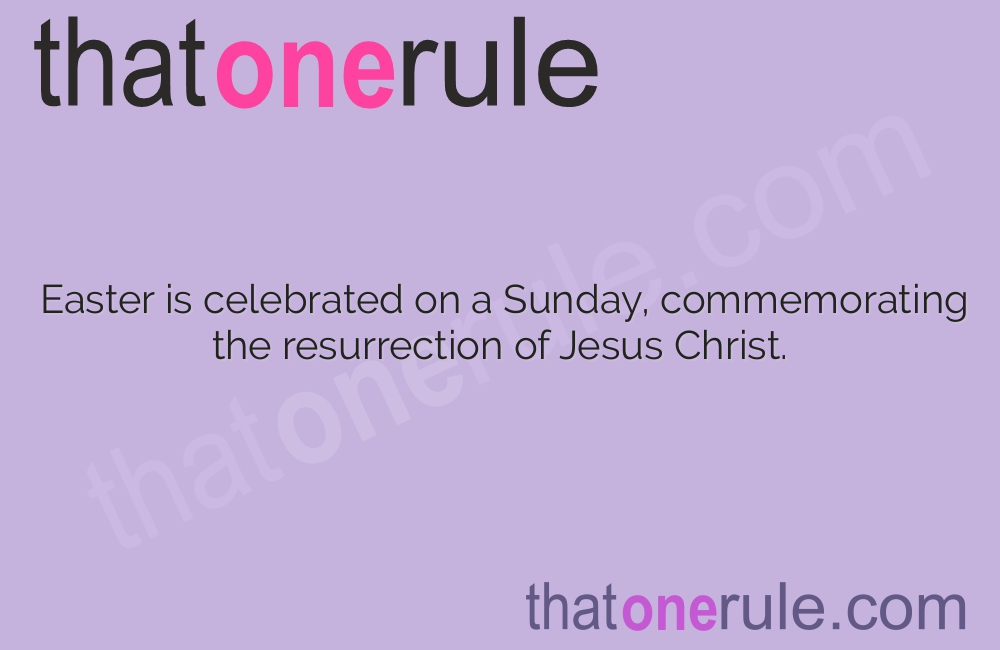Easter Facts – Surprising and Interesting Things About the Holiday

Easter is celebrated on a Sunday, commemorating the resurrection of Jesus Christ.
The word Easter is derived from the Old English word Eostre, which was the name of a pagan spring goddess.
Traditionally, eggs symbolize new life and rebirth, which is why they are associated with Easter.
The Easter Bunny is a symbol of fertility and abundance.
The first Easter eggs were dyed red, representing the blood of Christ.
In Greece and other Eastern European countries, it is traditional to play a game called egg tapping, where players try to crack each other’s eggs.
The largest Easter egg hunt ever recorded had 501,000 eggs hidden and took place in Florida in 2007.
In Australia, the Easter Bunny is often depicted delivering Easter eggs while hopping on a surfboard.
The world’s largest chocolate Easter egg was made in Italy in 20
It weighed 7,200 kg (15,873 lbs).
In Sweden, children dress up as Easter witches and go door-to-door exchanging drawings and paintings for candy.
The White House in the United States holds an annual Easter Egg Roll on its lawn, dating back to 1878.
Hot cross buns, a traditional Easter treat, have a cross on top to symbolize the crucifixion of Jesus.
The Easter Lily is often associated with Easter because its trumpet-like shape represents the trumpets that sounded at Jesus’ resurrection.
The act of giving chocolate eggs at Easter was popularized by the French in the 19th century.
Easter Facts – Surprising and Interesting Things About the Holiday part 2
In Ukraine, intricately decorated eggs called pysanky are made using a wax-resist method.
The date of Easter changes every year because it is based on the lunar calendar.
The largest chocolate bunny ever made was over 9 meters (30 feet) tall, weighing about 4,000 kg (8,800 lbs).
Morris dancing, a traditional English folk dance, is often performed on Easter Monday.
In Bermuda, people fly homemade kites on Good Friday to symbolize Jesus’ ascent into heaven.
The Easter parade, where people show off their new spring outfits, originated in New York in the mid-1800s.
The average American child receives about 75 Easter eggs each year.
In Finland, children dress up as Easter witches and paint their faces with bright colors.
The world record for the most people simultaneously blowing bubbles with chewing gum was set in Sweden on Easter Monday in 20
In Poland, Easter Monday is known as Śmigus-Dyngus or Wet Monday. People playfully splash water at each other.
The term Easter bonnet refers to a decorated hat worn by women and girls on Easter Sunday.
In Norway, it is a tradition to read crime novels and watch crime shows during Easter.
The record for the world’s largest Easter egg hunt was set in Florida in 2007, with over 9,750 participants.
Russian Orthodox Christians often greet each other during Easter by saying Christ is risen! and responding with Indeed, He is risen!
The largest chocolate egg mosaic was created in Italy in 2011, using 8,000 chocolate eggs.
In parts of Sweden, it is believed that witches fly to a mountain called Blåkulla on Easter Eve to party with the devil.
The average American consumes about 7 pounds of candy over the Easter holiday.
The tallest chocolate Easter egg tower was built in Belgium in 2005, standing at over 34 meters (112 feet) tall.
The Easter Vigil, a religious service held on Holy Saturday, is the first celebration of Easter in the Catholic Church.
In Spain, an elaborate procession called the Semana Santa takes place during the week leading up to Easter.
The record for the most colorful Easter eggs cracked with one hand in one minute was set in Ukraine in 2018, with 100 eggs.
The famous painting The Last Supper by Leonardo da Vinci depicts the Passover meal, which occurred just before Jesus’ crucifixion and resurrection.
In Mexico, it is common to celebrate Easter with the Burning of Judas, where effigies of Judas Iscariot are set on fire.
The tradition of giving Easter eggs dates back to the early Christian church, where eggs were given up for Lent and then reintroduced as a celebration of Jesus’ resurrection.
In Germany, it is believed that the Easter Bunny lays and decorates the eggs, rather than simply delivering them.
The oldest known Easter greeting is Christ is risen, which has been used since the 2nd century.
Easter is a moveable feast, meaning it falls on a different date each year based on the lunar calendar.
The largest egg rolling event takes place on the White House lawn in the United States, attracting thousands of children.
In Spain, it is common to eat a special Easter cake called Mona de Pascua, which is often decorated with colorful eggs.
In some parts of the world, it is traditional to exchange small gifts or presents on Easter Sunday.
Easter is a time for family and loved ones to come together, celebrate, and enjoy each other’s company.

